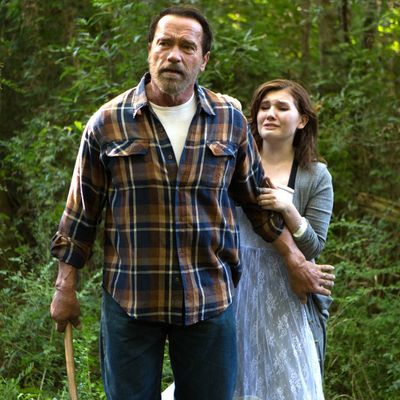
Of all our movie stars, Arnold Schwarzenegger has demonstrated the most colossal savior complex. This was a man who turned himself into a Teutonic Übermensch, who said pumping iron was like “blowing air through your muscles … like coming,” and whose film career saw him crushing seemingly indestructible robots, aliens, demons, and even the Devil himself. (When Schwarzenegger’s heroes didn’t survive, their deaths were Christ-like and/or Wagnerian.) This was the immigrant who boasted that he was bigger than our political system, pledging to rescue California and then — assuming he would triumph, which he always did — the U.S., and even the world.
His governorship, of course, didn’t turn out so well, and his subsequent return to acting has resulted in one humiliating flop after another. Age and a sex scandal having further diminished him, Schwarzenegger has now chosen to upend his image by playing a halting, helpless patriarch in Maggie — a zombie cannibal picture paced like a non-narrative Romanian art film in which he is, by the macho standards that he helped to establish, impotent.
It’s not a great movie, but it’s haunting, a sort of one-stop shop for a range of cultural anxieties — plague, environmental catastrophe, big government threatening the sanctity of home and family. Schwarzenegger is a farmer called Wade, which immediately makes him a bit of a laughingstock. (Why didn’t the filmmakers just add something to the script about his foreignness and change his name to something less ostentatiously midwestern?) When we meet him, he’s searching for his daughter, Maggie (Abigail Breslin), who has run away from home after being been bitten by a ghoul.
See, many Americans have become mindless cannibals — called “necro-ambulists,” a pretentious way of saying “walking dead” — and they’re contagious. Once infected, victims have about eight weeks before they “turn,” the symptoms explained by an NPR announcer as Wade drives his rattletrap pickup along a barren road. As soon as they start staring at family members and licking their chops, it’s time to have them quarantined — which in this case means thrown into warehouses to be torn apart by other ghouls or else painfully euthanized. Apparently the U.S. government is no more competent or caring than it was in the influenza epidemic of 1918.
Having vowed to his beloved dead wife that he’d always protect their daughter, Wade is determined to keep Maggie home in the bosom of her family. So he sends his young kids by his second wife, Caroline (Joely Richardson), to their aunt, and then sets about … well, not doing much of anything. For long stretches, he sits morosely in dark rooms beside Maggie, her skin growing whiter, her capillaries blacker, her blue eyes milkier. The time to have her quarantined looms. The local police have known Wade all his life and they’re sympathetic, but they must, they say, think of the good of the town. After one unpleasant visit, a cop looks at him sternly and says, “I’ll be back.” And Schwarzenegger stares at him dumbly, unable to reply.
Maybe by taking this role (and co-producing the film), Schwarzenegger was trying to emulate tough guys like Clint Eastwood, who turned his career around with Unforgiven, or his pal Sylvester Stallone, who won a smidge of critical respect for playing a chunky drunk in Copland. But for all the hand-wringing in Unforgiven, Eastwood’s character ended up blowing all the bad guys away, and so did Stallone (with less hand-wringing) in Copland. Maggie isn’t that sort of film. Wade simply cannot overcome nature or his government, and Schwarzenegger uses his loss of stature and haggard visage to generate an enormous amount of pathos. In one scene, Wade and Maggie stumble on a neighbor and the neighbor’s little girl, both of whom have “turned.” The director, Henry Hobson, keeps the ghouls at a distance, shrouded in darkness and motionless, gazing on Wade as Wade gazes on them, his awareness of his daughter — who’ll soon be like them — raising his level of anguish exponentially.
That said, Schwarzenegger still can’t deliver a line of dialogue without sounding as if he learned it phonetically, and most of Maggie is so dark you can barely make out the zombies or the humans. It also moves more slowly than the ghouls. In the last third, though, Hobson and screenwriter John Scott 3 [sic] hand the narrative reins to Maggie herself, and the movie is better for it. Breslin is a fine, unshowy actress, and as a girl with what’s essentially a terminal illness, she’s just as affecting as Shailene Woodley in The Fault in Our Stars. In one scene, she impulsively cuts off a finger that has begun to rot, and it’s not the gore that does a number on you but the rage at her own body. In an even more wrenching scene, she goes on a date with some friends — everyone knows it will be the last time — and sits with an infected teenage boy who’s farther along than she is. The film becomes, briefly, a tragic romance, and it’s not just these two but also a whole way of life that seems to be rotting before our eyes.
That’s the takeaway, alas. No matter how much this culture worships superheroes — some Marvel, some DC, some played by Schwarzenegger — we can’t save the next generation from … well, pick your poison. Arnold has left the field. The kids won’t be alright.


